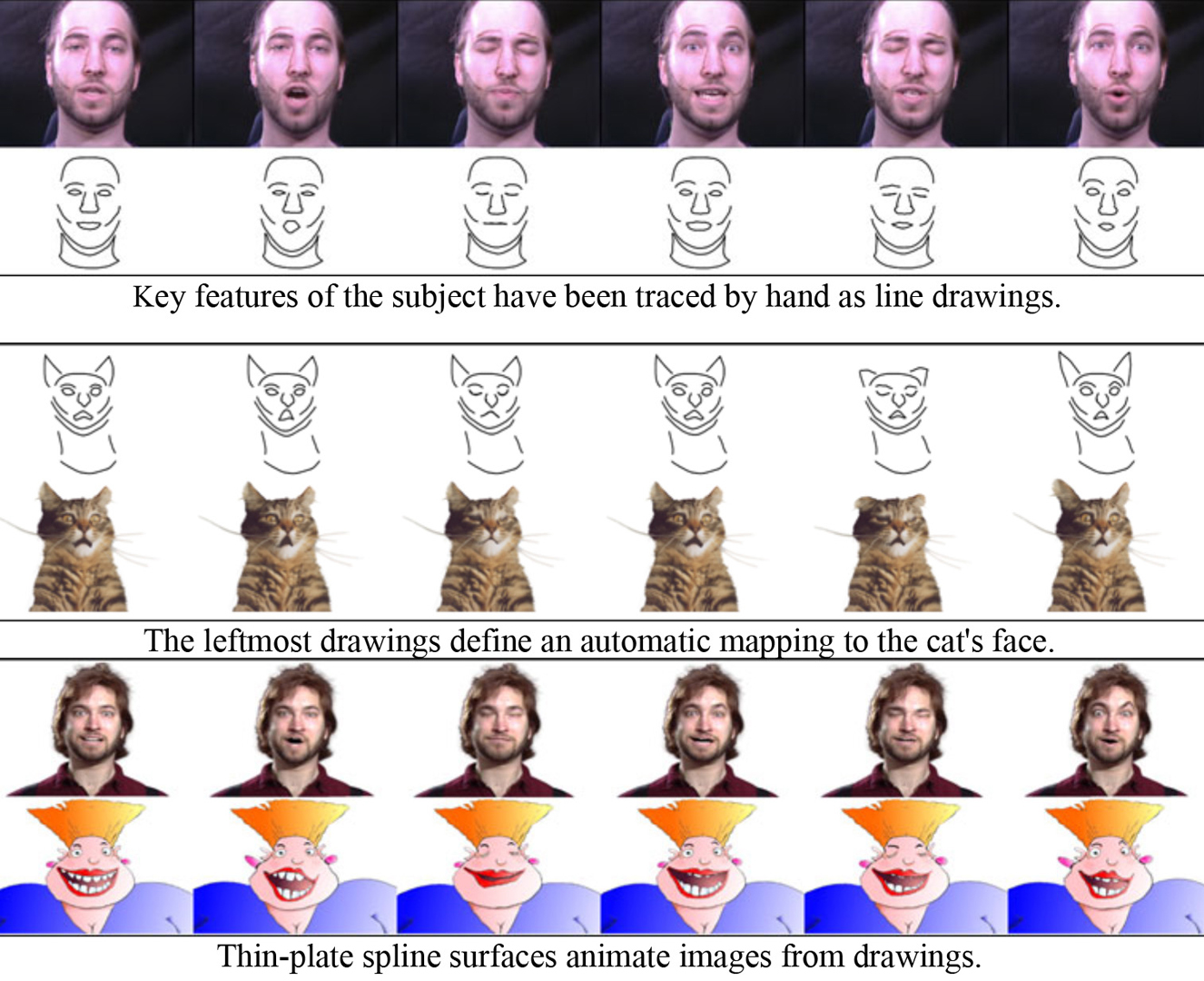“Animating images with drawings” by Litwinowicz and Williams
Conference:
Type(s):
Title:
- Animating images with drawings
Presenter(s)/Author(s):
Abstract:
The work described here extends the power of 2D animation with a form of texture mapping conveniently controlled by line drawings. By tracing points, line segments, spline curves, or filled regions on an image, the animator defines features which can be used to animate the image. Animations of the control features deform the image smoothly. This development is in the tradition of “skeleton”-based animation, and “feature”-based image metamorphosis. By employing numerics developed in the computer vision community for rapid visual surface estimation, several important advantages are realized. Skeletons are generalized to include curved “bones,” the interpolating surface is better behaved, the expense of computing the animation is decoupled from the number of features in the drawing, and arbitrary holes or cuts in the interpolated surface can be accommodated. The same general scattered data interpolation technique is applied to the problem of mapping animation from one image and set of features to another, generalizing the prescriptive power of animated sequences and encouraging reuse of animated motion.
References:
1. Beier, T. and S. Neely. “Feature-Based Image Metamorphosis,” Computer Graphics, Volume 26, Number 2, July 1992, pp. 35-42.
2. Burtnyk, N. and M Wein. “Interactive Skeleton Techniques for Enhancing Motion Dynamics in Key Frame Animation,” CACM, Vol. 19, Number 10, October 1976.
3. Farin, G. Curves and Surfaces for Computer Aided Geometric Design, A Practical Guide, Second Edition. Academic Press, NY, 1990.
4. Forrest, A. “On Coons and Other Methods for the Representation of Curved Surfaces,” Computer Graphics and Image Processing, 1, 1972, pp. 341-369.
5. Franke, R. “A Critical Comparison of Some Methods for Interpolation of Scattered Data,” Report NPS-53-79-03 of the Naval Postgraduate School, Monterey, CA. Obtained from U.S. Department of Commerce, National Technical Information Service.
6. Gerald, Curtis and P. Wheatley, Applied Numerical Analysis, Fifth Edition, Addison-Wesley Publishing Company, pp. 159-164.
7. Gortler, Steven, Michael Cohen and Philipp Slusallek, “Radiosity and Relaxation Methods: Progressive Refinement is Southwell Relaxation,” Princeton University Research Report CS-TR-408-93, February 1993.
8. Goshtasby, A., “Piecewise Linear Mapping Functions for Image Registration,” Pattern Recognition 19:6, 1986, pp. 459-466.
9. Grimson, W., From Images to Surfaces, MIT Press, 1981.
10. Harder, R., and R. Desmarais, “Interpolation Using Surface Splines,” J. Aircraft, Vol. 9, February 1972, pp. 189 -191.
11. Litwinowicz, P. “Inkwell: A 2 1 / 2 -D Animation System,” Computer Graphics, Volume 25, Number 4, 1991, pp. 113-121.
12. Patterson, E., P. Litwinowicz and N. Greene, “Facial Animation by Spatial Mapping,” Computer Animation 1991, Springer-Verlag, NY 1991, pp. 31-44.
13. Pilcher, David, “Smooth Parametric Surfaces,” in Computer Aided Geometric Design, by Barnhill and Riesenfeld, Academic Press, NY, 1974, pp. 237-253.
14. Ruprecht, D., and H. M~ller, “Image Warping with Scattered Data Interpolation Methods,” Research Report 443, Dortmund University, November 6, 1992.
15. Shepard, D., “A Two-Dimensional Interpolation Function for Irregularly Spaced Data,” Proceedings of the 23rd Nat. Conf. ACM, 1968, pp. 517-523.
16. Sederberg, T. and S. Parry. “Free-Form Deformation of Solid Geometric Models,” Computer Graphics, Volume 20, Number 4, August 1986, pp. 151-160.
17. Terzopoulos, D. “The Computation of Visible-Surface Representations,” IEEE Transactions on Pattern Analysis and Machine Intelligence, Vol. 10, No.4, July 1988.
18. Wolberg, George. “Skeleton Based Image Warping,” The Visual Computer, Vol. 5, Number 1/2, March 1989, pp. 95-108.
19. van Overveld, C. W. A. M., “A technique for motion specification in computer animation,” The Visual Computer, Number 6, 1990, pp. 106-116.





